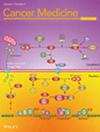Associations of Biomarkers of Systemic Inflammation, Angiogenesis, and Cell-to-Cell Adhesion With Tumor Budding Among Early-Onset and Later-Onset Colorectal Cancer Patients
Abstract
Background
High tumor budding and elevated systemic inflammation are adverse prognostic indicators in colorectal cancer. Its underlying mechanisms remain poorly understood. It is unclear whether systemic inflammation, angiogenesis, and cell-to-cell adhesion influence tumor budding.
Methods
We investigated n = 132 stage I–III colorectal cancer patients recruited at Huntsman Cancer Institute enrolled in the ColoCare Study. Tumor budding was evaluated using an evidence-based scoring system, and patient sera were analyzed for nine circulating biomarkers using the Meso Scale Discovery platform. We examined associations between biomarkers and tumor budding using multivariable linear regression models adjusted for age, sex, neoadjuvant treatment, stage, and non-steroidal anti-inflammatory drug use.
Results
The study population was predominantly non-Hispanic White (95%), with a mean age of 61 years; 56% were male. Most tumors were stage III (47%), located in the colon (64%), and exhibited low-grade tumor budding (58%). Soluble intercellular adhesion molecule 1 was inversely associated with tumor budding overall (M1: β = −0.57, p = 0.03), among females (M1: β = −0.81, p-value = 0.03) and later-onset (≥ 50 years) colorectal cancer (M1: β = −0.71, p-value = 0.008). C-reactive protein was positively associated with tumor budding in males (M1: β = 0.23, p = 0.001), while interleukin-8 (M1: β = 0.96, p-value = 0.01) and soluble vascular adhesion molecule 1 (M2: β = 1.48, p-value = 0.04) were positively associated with tumor budding in early-onset patients. However, these associations did not remain statistically significant after correction for multiple testing.
Conclusion
Overall, our findings do not provide evidence of a significant association between biomarkers of systemic inflammation, angiogenesis, and cell-to-cell adhesion with tumor budding count. We observed patterns for some biomarkers, yet none remained statistically significant after correction for multiple testing. These findings provide preliminary insights for future studies.
Trial Registration: ClinicalTrials.gov: NCT02328677.


 求助内容:
求助内容: 应助结果提醒方式:
应助结果提醒方式:


